 This timely conference organised by Seas At Risk in Brussels, 5 February 2020, put all the emphasis where it urgently belongs: on to implementation and action! Taking issue with the gulf between talk and action, even between legislation supposed to be enacted, but regularly broken and ignored without consequences for the perpetrators in high office and in implementation agencies alike, the consortium supporting the conference had elaborated a Blue Manifesto of an implementation roadmap between now and 2030 to meet commitments.
This timely conference organised by Seas At Risk in Brussels, 5 February 2020, put all the emphasis where it urgently belongs: on to implementation and action! Taking issue with the gulf between talk and action, even between legislation supposed to be enacted, but regularly broken and ignored without consequences for the perpetrators in high office and in implementation agencies alike, the consortium supporting the conference had elaborated a Blue Manifesto of an implementation roadmap between now and 2030 to meet commitments.
The day started with a number of "wake-up" calls. They sat well in the atmosphere of blending sciences and arts to a culture of care which permeated the conference and was visible in the use and decoration of spaces. The first session featured Monica Verbeek, Executive Director of Seas At Risk, Hans Bruyninckx, Executive Director of the European Environment Agency in Copenhagen, Prof. S. Fletscher of the University of Portsmouth and Chair of the UN International Resource Panel, and Easkey Britton, Marine social scientist, surfer and member of the Horizon2020 SOPHIE project.
 There is little evidence so far contrasting the harrowing indicators that together point in the wrong direction, despite some improvements here and there. The human footprint of using natural resources is growing fast and continued demographic growth is not slowing it down either.
There is little evidence so far contrasting the harrowing indicators that together point in the wrong direction, despite some improvements here and there. The human footprint of using natural resources is growing fast and continued demographic growth is not slowing it down either.
Instead of repeating more of the extremely worrying numbers, most speakers at the conference focused on how to address the implementation gap: how to finally do, what has been promised since a long time, before it's too late. Avoiding tipping points with irreversible impacts and those strongly connected to others in the climate and resource systems should be a top priority.
Practitioners from Spain, Ireland and Croatia illustrated how important it was to persevere and keep connecting to affected citizens and their organisations in pursuit of local environment protection, whether in the sea or on the land. Establishing trustful relations among different groups engaged in nature protection and defense of local livelihoods and seeking as many allies and helpful intermediaries as possible had been important in the struggles. If public protests were insufficient and the legal route had to be taken, the costs can be very steep unless supported by crowdfunding and favourable lawyers.
 The last morning panel included Claire Nouvian, Founder and Board Chair of Bloom, who did not mince her words of mistrust in slick political speeches, which sounded good, bound the energies of activists, but did not lead to any implementation of long agreed measures for climate and ocean protection. She was particularly aggravated by the European Parliament voting to continue harmful fisheries subsidies in breach of the 2004 prohibition. That was a slap in the face of efforts to finally phase them out through the World Trade Organization (WTO), deadline 2020.
The last morning panel included Claire Nouvian, Founder and Board Chair of Bloom, who did not mince her words of mistrust in slick political speeches, which sounded good, bound the energies of activists, but did not lead to any implementation of long agreed measures for climate and ocean protection. She was particularly aggravated by the European Parliament voting to continue harmful fisheries subsidies in breach of the 2004 prohibition. That was a slap in the face of efforts to finally phase them out through the World Trade Organization (WTO), deadline 2020.
Lola Segers, Climate activist from Youth for Climate Belgium listed their long drawn out campaign activities, but conceded that most politicians were not seriously engaging and that it would take a variety of new forms of action to keep young people mobilised.
Liam Geary Baulch, Artist and activist with Extinction Rebellion, still believes asking citizens to engage around love and caring for Earth, facing the grief of animal and plant extinctions, is a feasible pathway to increase mobilisation, especially if media coverage is adequate.
 Peter Thomson, Special Envoy for the Ocean for UN Secretary General António Guterres, spoke to conference participants in a video-message right after lunch. He alerted everybody again to the forthcoming UN Ocean Conference in Lisbon in June, where he expected more ambitious pledges to implement SDG 14 and make up for lost ground from lack of action in the first five years since 2015.
Peter Thomson, Special Envoy for the Ocean for UN Secretary General António Guterres, spoke to conference participants in a video-message right after lunch. He alerted everybody again to the forthcoming UN Ocean Conference in Lisbon in June, where he expected more ambitious pledges to implement SDG 14 and make up for lost ground from lack of action in the first five years since 2015.
His top targets are: stop single-use plastic altogether; protect 30% of the ocean from exploitation bringing the current UN negotions to a successful conclusion, advance with marine spatial planning for conflict reduction and - many participants, including Mundus maris would have added: phase out new oil and gas exploration! But these seem to be increasing frenetically. The acceleration of overexploitation can often be observed before international agreements come into force and then only manage the sad remnants.
Following this call for action, participants broke out into small conversations of six challenges in each of four workshops:
1. Communicating to the general public on ocean emergency
2. Addressing governance obstacles
3. Enforcing the Law of the Sea
 4. Redirecting finance flows to support ocean conservation and restoration rather than activities harming the ocean
4. Redirecting finance flows to support ocean conservation and restoration rather than activities harming the ocean
5. Overcoming unsustainable consumption and production patterns
6. Addressing the social aspects of the transition to a healthy ocean.
Mundus maris participants, Patricia Morales and Cornelia E Nauen, focused on challenge four. Cornelia summarised the group findings for the other workshop participants. All key results of the challenge discussions in the workshops were graphically recorded and then presented back in the plenary.
Virginijus Sinkevičius, the member of the European Commission responsible for Environment, Oceans and Fisheries, welcomed the Blue Manifesto cautiously. He said he was arguing for 30% of the next medium-term budget from 2021 to 2027 to be allocated to fund climate neutrality in Europe.
A group of senior policy makers was then called to the stage to position themselves in relation to the demands and the concrete roadmap presented in the Blue Manifesto for action supported by a very large number of civil society organisations and others. They were Hans Bruyninckx of EEA, Heike Imhoff, Director of Marine Affairs in the German Federal Ministry for the Environment, Nature Conservation and Nuclear Safety, Pascal Lamy, former WTO boss, currently Chair of the Mission Board for 'Healthy Oceans, Seas, Coastal and Inland Waters', Bernhard Friess, actg Director General of DG MARE and Monica Verbeek.
 The general tone was very prudent as key budget negotiations were still forthcoming, though a reinterpretation of the industrial investment drive that appears to run through president von der Leyen's "Green Deal" might, after all, leave some space for nature protection. Even for inexperienced observers it was clear that the environment continued to be the poor relative barely admitted to the high table. That gave a sense of how much more public mobilisation was needed to become real with implementing the existing laws and commitments.
The general tone was very prudent as key budget negotiations were still forthcoming, though a reinterpretation of the industrial investment drive that appears to run through president von der Leyen's "Green Deal" might, after all, leave some space for nature protection. Even for inexperienced observers it was clear that the environment continued to be the poor relative barely admitted to the high table. That gave a sense of how much more public mobilisation was needed to become real with implementing the existing laws and commitments.
Avoiding to leave the audience depressed, the last session was entirely left to professionals with a demonstrated track record of touching millions with the stories of the urgency of ocean and biodiversity protection. James Honeyborne, Executive producer of Blue Planet II, Jonathan Smith, Producer, and Nicola Brown, Impact producer allowed glimpses into the making of the film. First principle is to entertain and emotionally engage viewers. Only when viewers are well engaged can they be confronted with the difficulties of protecting the ocean. And only when they really care, will viewers be ready to take action themselves. How to get to this point passed not only through more than thousand hours of underwater footage, but also the creative way in which new filming equipment had allowed to transport viewers into the natural world like never before. Accompanied by a savvy social media campaign let the numbers of followers skyrocket within days to 28 million. Wow! Who hasn't seen Blue Planet II.
A very different type of story telling closed that working day before the party - Rik de Droominee, spoken word artist. 30 years of Seas At Risk are worth celebrating. A lot of work lies ahead to implement the Blue Manifesto in the next 10 years. Roll up your sleeves and team up. Not easy, but it can and must be done.

The Damaged Beauty of Water, a collective production under the guidance of artist Massoud Lari of Ateliers Créatifs du Chant d'Oiseau was exposed together with other art work in the entrance hall and throughout the conference venue.
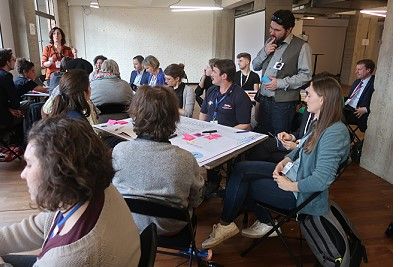 |
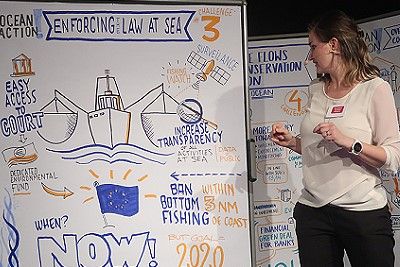 |
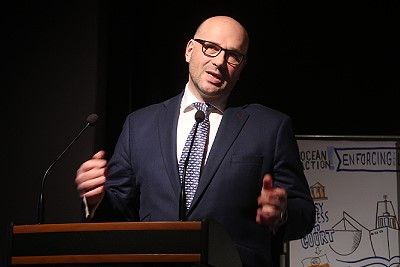 |
 |
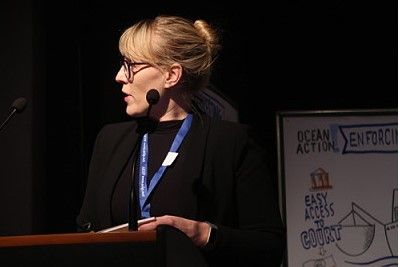 |
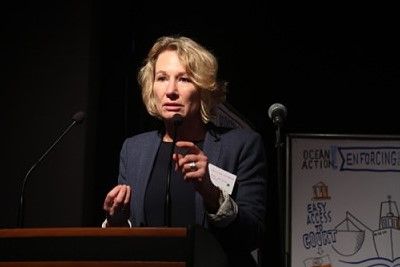 |








